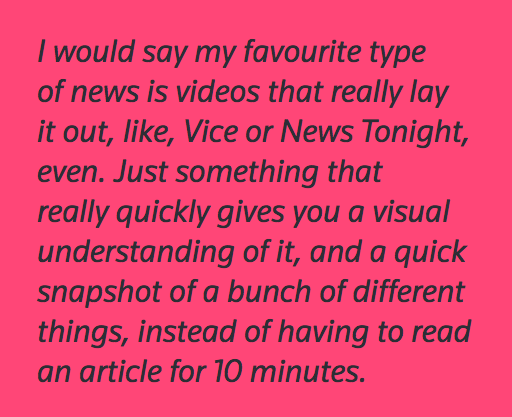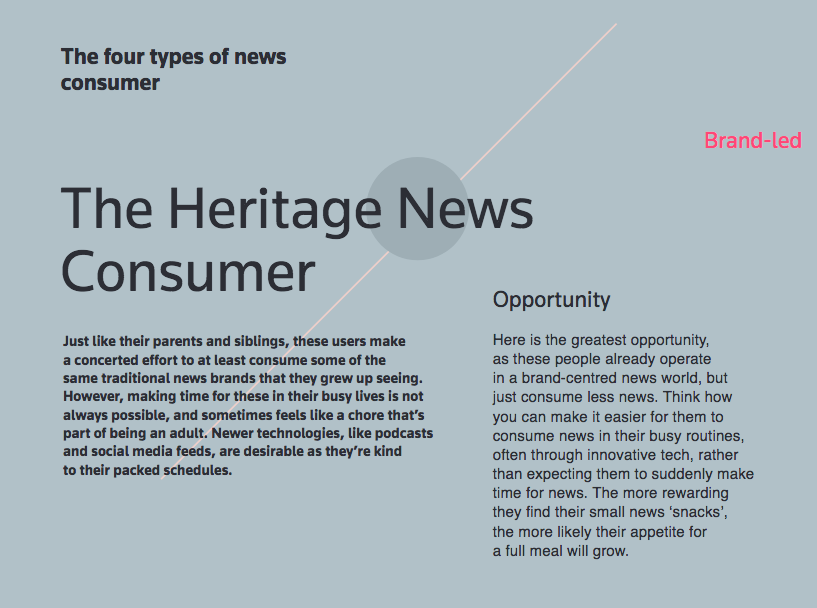
Young audiences want instant gratification from news without it being dumbed down, according to new research by The Reuters Institute for the Study of Journalism (RISJ) and strategic insight consultancy Flamingo.
The study How young people consume news and the implications for mainstream media takes into account two generations of UK- and US-based young audiences: Gen Y (millennials) and Gen Z (those under 23).
These two generations are digitally native and migrant, meaning the pre-internet era is only a faint memory for some. This has created a complex set of news preferences.
Across the board appetite for news content is consistent, but young people consider accessing the news "a chore" because of publisher's choice of format, approach and tone.
"This isn’t an incremental change, it’s generational with different attitudes," said senior research associate, Nic Newman, RISJ, speaking to Journalism.co.uk before the research launch event yesterday (2 September 2019).
"The past models won’t work if you apply them and expect people to grow up – that’s not going to happen, that’s the starting point."
To understand the full picture of their habits, preferences and motivations, RISJ gathered data from consented mobile tracking, conducted interviews and analysis of sign processes.
To little surprise, audiences have developed a taste for quick hits of global and personalised information.

"They want convenience, they want frictionless access – some will pay for quality content – they want a combination of news that is relevant to their lives, and they want to know what everyone needs to know," said Newman.
"There's literally no patience. If you think about how traditional organisations have set up their sites to be interruptive and not load instantly, it’s not hard to see why those experiences have not resonated in the way Facebook and Instagram, for example, has."
As an overview, the zero tolerance for anything other than instant gratification holds true. But diving into the research finds four different types of news consumers: heritage news consumer, passive news absorber, dedicated news devotee and proactive news lover. Each reacts differently to four different types of content: dedicated, updated, time-filler and intercepted.
It is this precise dynamic which publishers need to be wrestling with. Within those preferences, there are key "moments" where audiences will come to the news, a key shift from when the news has traditionally come to audiences with morning newspapers and evening bulletins.
The biggest potential for publishers to secure paying news readers lies in 'heritage consumers'. As an example, these have residual loyalty from their parents and snack on content around their busy routines.

"There is a lot of time for those interruptive moments, we are seeing it with some young people habits and dedicated moments emerging, on weekends and looking at newspapers or listening to a podcast on commutes," said Newman.
"In the meantime, what we’ve seen with the arrival of the internet is the time suddenly getting blurred. What we are realising is that this isn't good for us either and that people are trying to find habits and the benefits of being updated throughout the day."
So figuring out how to cater to the many needs is the prevailing problem for publishers. The research shows that young audiences value news which helps with self-development whilst providing a source of entertainment. At the intersection of these two values are podcasts, said Newman, explaining the boom of their popularity.
"If you listen to a lot of new generation, narrative daily podcasts, they are character-driven, very entertaining and popular with young people – but they are diving into detailed, deep topics," he explained.
"There are some examples where you can [satisfy both needs] – but for me, the headline is: you cannot just do it with digital. You need a number of different touchpoints moving forward to engage people with the brand."
The research identifies that young audiences are spending less time with news websites and apps and calls on publishers to try to emulate the experiences of Facebook and Netflix, to weave content into preferences and to reconsider the values of the news in terms of inclusiveness, negativity and agenda.
Should that be firing off alarm bells in publishers minds? After all, of the 4400 minutes a young person spends on their phone per week, not one news app breaks into the top 25 most popular.
Three publishers attended the launch event and explained how they are approaching the various needs of young audiences.
The best comment/question of the evening comes, as it often does, from @rasmus_kleis - "you (the panel) don't look freaked out by the findings." The panel broadly agreed that it's a good thing that young people at least are interested in news. pic.twitter.com/nOR6dhXnwg
— Dmitry Shishkin (@dmitryshishkin) September 2, 2019
Nick Petrie, deputy head of digital, The Times and The Sunday Times identified how the publisher has developed a university pilot scheme to gain feedback and loyalty with readers throughout their studies, as its digital subscriber base grows.
"What encourages me is that they are valuing the news at some level, be that tones, presentations, whatever. The product isn't the problem, the delivery is and the way in which they find it.
"All that attention about how to create great experiences for users has gone on Facebook and Instagram, actually I think fundamentally we have an execution problem."
Nathalie Malinarich, mobile and new formats editor, BBC News leads the Cut Through The Noise channel on the broadcaster's Facebook page.
It is a significant example of a social- and mobile-first video series with a solutions lens - two of the major demands coming from the study - aiming to keep audiences around in the future.
"No one is denying this is a huge challenge, there's lots of testing but I'm not freaking out yet. I don't think people will grow up and use the news in the way that we do. They will use the news, but it will be completely different. If we don't do anything, we are screwed."
Polly Curtis, editor, Tortoise noted how the startup uses Think-Ins to communicate with their membership base to know what the editorial teams should be covering.
The startup claims that 40 per cent of its members are aged under 30. This young audience often wants to know more about stories that appear on social media, such as the Sudan crisis.
"It transpired there had been an Instagram meme around the Sudan crisis that had compared Sudan with Notre Dame and questioning news values. This had been everywhere but no one was addressing the meat to that story," she said.
"If we do journalism that is one-dimensional, we aren't getting the full story, the challenge and the ideas that we need to do a different kind of journalism. It gives us the challenge that we are producing journalism that is right for a big, broad audience."
Find out how to regain audiences’ trust by driving diversity in your newsroom at Newsrewired on 27 November at Reuters, London. Head to newsrewired.com for the full agenda and tickets
Free daily newsletter
If you like our news and feature articles, you can sign up to receive our free daily (Mon-Fri) email newsletter (mobile friendly).
Related articles
- 15 free sources of data on the media industry
- Building trust during 2024 elections with live-blogging and fact-checking
- Bloomberg Media and Puck's subscription strategy: 'wake up the sleepers and prioritise the keepers'
- New blockchain verification tool to help fight the use of deep fakes in elections
- Trust is not a "useless metric" - we just need to understand it better









